The Carrot & The Stick
Saturday, March 06, 2010
 For close to 12 years we have been getting Rebecca (and then also her sister Lauren when she was born 8 years ago) on Saturdays. Both of her parents work so we do babysitting support. Rebecca routinely babysits, on her own, for some neighbours so the writing is on the wall for us. Soon Rebecca might be trusted to take care of her sister at home or perhaps she will simply become an independent teenager, who will stay at home while we take care of Lauren. For most of these years the Saturdays have been pleasant and heartwarming days when we have attempted to challenge the girls (the stick) with music, gardening, museum-going, ballet and modern dance evenings or concert evenings. The last one was a Gershwin concert at the VSO a few weeks back. I have picked films that I thought Rebecca should be exposed to such as Tarzan The Ape Man, Gunga Din and The Red Shoes. But “too much” culture can make little girls’ interest diminish so we have applied the carrot with plenty of food goodies they like like “double-stuff” Oreos and an unlimited access to the fridge. It has been Rosemary who has warned me about being too strict with Rebecca as she will not want to come to our house when she does not see the fun of it. For a while I enjoyed whacking (gently) them on the head with the TV remote. When Lauren described this to her other grandmother I received a phone call from my daughter to cease the abuse, or else. It is generally understood that grandparents play (when living in the same city) a necessary role in the education of their grandchildren. If the grandparents have funds in the bank, the help can be a financial one. If the parents work and cannot afford a babysitter, grandparents become surrogate babysitters. The above can be seen in strictly objective terms. Grandparents do as they are told and perform as is expected of them. But there is a subjective side to this. Grandchildren can grow on the grandparents. When they leave on Saturday nights we are left with a feeling of emptiness. The fine line between the carrot and the stick then becomes important when the implied (even if never uttered out loud) threat of ending the Saturdays and the Mondays (I pick up the girls at school on Mondays) is understood. And with Rebecca at 12 it is only a matter of short time when going on a date with a girl or boy friend will trump a Saturday visit to the boring grandparents. This is inevitable and I can see the day coming. I keep telling Rosemary that we need to think of alternatives or our life will feel vacant.  Yesterday, Saturday was a preview of things to come. Rebecca brought her well-mannered friend Jessica. We took the three girls (including Lauren) to Watermania in Richmond. Jessica and Rebecca played and chatted in the water. They cast their disapproving eyes on a young boy who was extremely overweight. At one point I asked Rebecca if she wanted to swim some lengths with me so she could practice her beautiful backstroke. Her, “No,” was predictable. At age 67 one side of me objected at the idea of having to share my precocious granddaughter with her friend. But I also understood that this was the way it had to be and perhaps some day in the not so near future I might again have a relationship with my granddaughter that will be mature as we explore cultural events together. I watched Lauren in the wave pool. She is now not in the least afraid of the water. She has developed a self-confidence reflected by a wide smile as she navigated the deep end in a foam float. She would fall off every once in a while but there was no panic in her face. It was comforting to see her as it was to see Rosemary hovering around and keeping a watch. Last night I caught Rebecca using her hands to pick up the shredded Parmesan to put on her gnocchi. “There is a spoon for that! I am shocked at your manners,” I told her, in the presence of her friend. Rebecca's wise mother turned to tell me, “There are times when you should not pursue a battle. This is one such time.”
Man Eats Dog
Friday, March 05, 2010
Over There
Faith Healing and the Original Hot Dog
By Mati Laansoo
Illustration by Marv Newland
Vancouver Magazine, March 1982
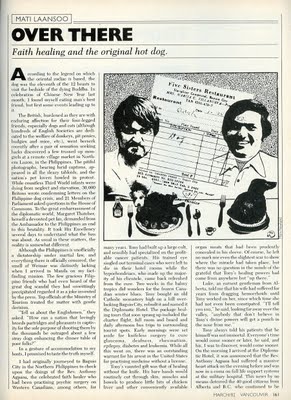
According to the legend on which the original zodiac is based, the dog was the eleventh of the 12 beasts to visit the bedside of the dying Buddha. In celebration of Chinese New Year last month, I found myself eating man’s best friend; but first some events leading up to it.
The British burdened as they are with enduring affection for their four-legged friends, especial dogs and cats (although hundreds of English Societies are dedicated to the welfare of donkeys, pit ponies, budgies and mice, etc.), went berserk recently after a pair of sensation seeking hacks discovered a few trussed up mongrels at a remote village market in Northern Luzon, in the Philippines. The pitiful photographs, bearing lurid captions, appeared in the sleazy tabloids, and the nation’s pet lovers howled in protest. While countless Third World infants were dying from neglect and starvation, 30,000 Britons wrote condemning letters on the Philippine dog crisis, and 21 Members of Parliament asked questions in the House of Commons. To the great embarrassment of the diplomatic world, Margaret Thatcher, herself a devoted pet fan, demanded from the Ambassador to the Philippines and end to this brutality. It took His Excellency several days to understand what the fuss was about. As usual in these matters, the reality is somewhat different.
Although the Philippines is unofficially a dictatorship under martial law, and everything there is officially censored, the smell of Weimar was distinctly lacking when I arrived in Manila on my fact-finding mission. The few gracious Filipino friends who had even heard of the great dog scandal they had unwittingly precipitated regarded it as a joke invented by the press. Top officials of the Ministry of Tourism treated the matter with gentle derision.
“Tell us about the Englishmen,” they asked. “How can a nation that lovingly breeds partridges and pheasants in captivity for the sole purpose of shooting them by the thousands be outraged about a few stray dogs enhancing the dinner table of poor folks? ”
In a gesture of accommodations to my hosts, I promised to taste the truth myself.
I had originally journeyed to Baguio City in the Northern Philippines to check upon the doings of the Reverend Anthony Agpaoa, the celebrated faith healer who had been practicing psychic surgery on Western Canadians, among others, for many years. Tony had built up a large cult, and sensibly specialized on the profitable cancer patients. His trained eye singled out terminal cases who were left to die in their hotel rooms while the hypochondriacs, who made up the majority of his clientele, came back refreshed from the cure. Two weeks in the balmy tropics did wonders for the frozen Canadian winter blues. Tony bought and old Catholic monastery high on a hill overlooking Baguio City, rebuilt it and named it the Diplomatic Hotel. The package healing tours that soon sprang up included the charter flight, full room and board and daily afternoon trips to surrounding tourist spots. Early mornings were set aside for knifeless surgery to cure glaucoma, deafness, rheumatism, epilepsy, diabetes and leukemia. While all this went on, there was an outstanding warrant for his arrest in the United States for practicing medicine without a license.
Tony’s vaunted gift was that of healing without the knife. His bare hands would routinely cut through skin, muscles and bowels to produce little bits of chicken liver and other conveniently available organ meats that had been prudently concealed in his sleeve. Of course, he left no mark nor even the slightest scar to show where the miracle had taken place, but there was no question in the minds of the grateful that Tony’s healing powers had come from anywhere but “up there.”
Tony always told his patients that he himself was not immortal. Everyone’s time would come sooner or later, he said and his, I was to discover, would come sooner. On the morning that I arrived at the Diplomatic Hotel, it was announced that the Rev. Anthony Agpaoa had suffered a massive heart attack on the evening before and was now in a coma on full life support systems at the military hospital. This news by no means deterred the 40 good citizens from Alberta and B.C. who continued to be operated on by four assistant healers, suspicious looking youngsters in T-shirts and Adidas runners who bore an uncanny resemblance to Manila cab drivers.
But back to the main story: man eats dog. The morning’s doings at the Diplomatic having left me somewhat puckish, my guide drove me to the Five Sisters Restaurant of the Slaughterhouse Compound. There I met the jovial proprietress Mrs. Marcia C. Villaneuve, a locally celebrated cook. The restaurant was empty except for a lone Jeepney driver eating his daily dog, and a quiet foursome dining on a mixed menu that included the house specialty. I learned from Mrs. Villaneuve that in the remote barrios of the Philippines, where the average income is less than $5 a week, homeless mongrels are sometimes sold for food instead of being gassed to death by the SPCA. She went on to point out that “fragrant meat,” as the Chinese call it, is considered a delicacy only when the diners know that it is dog they are eating.
I ordered a round of San Miguel beer for the Five Sister’s lunchtime patrons and a plate of canine casserole for me and my guide. The dish arrived promptly, a rather nondescript gray in appearance, its gravy dotted with a few bay leaves. The taste was very much like some of the better Chinese meat dishes done in garlic and black bean sauce: a bit chewy, somewhat spicy and vaguely redolent of pigs’ trotters with all the little leg bones and knuckle joints to crush on. Appearances notwithstanding, it was very tasty, and arguably good value at 10 Pesos, or $1.35.
Of course, I complimented Mrs. Villaneuve on the delicacy of her dish, and she in turn beamed her approval and suggested that I pass on the recipe for culinary adventurers overseas. The carcass she said, should be skinned and hanged by a competent butcher, after which the choice meat should be cut into bite-sized pieces and cooked in rice vinegar for a very long time until it becomes “al dente.” After that, the meat is salted and simmered in a broth of oil, garlic, bay leaf and pepper, with a dash of monosodium glutamate to bring out the bouquet. It is then served piping hot in its own rich gravy, with a side order of fried noodle and sliced green mangoes. All cultural impediments aside, the dish (as many early European navigators in the region have testified) is delicious, although like the barnyard chicken who has become familiar enough to have earned a name, likely less so if you happen to have known the dish wagging its tail earlier.
I confess that after my Philippine luncheon I now look at my canine friends with renewed respect, and rather suspect that the feeling is mutual. These days, whenever I meet dogs fooling around in the street or being tedious at the pub, I just point my finger at them, like Charles Bronson in Death Wish, and they smarten up real quick, because they know.
An Apology For My Rosy Past
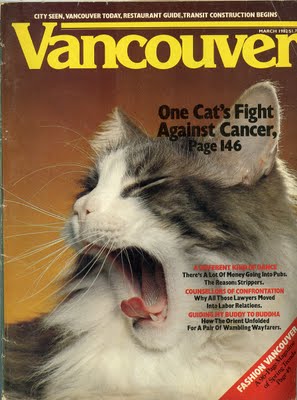 Some of you might suspect that I am running out of ideas and inspiration to write my daily blog and that I am getting ready to shelve the now four-year-plus project. This would be far from the truth as I have no problem in drumming up stuff to put up here. If anything one of my problems is to stop my desire for multiple blogs in one day. This is a rare example of one. So why is it that I am resorting to pulling a Lazarus on articles written many years ago by writers that I admired who worked for the magazine, Vancouver Magazine, run by Mac (a.k.a Malcolm ) Parry? You might suspect that to anybody my age (67) the past will always be rosier and better. In fact I would not agree with you. So much stuff nowadays is so much better. When we arrived to Vancouver in 1975 the city’s bread was a distinct but nondescript variety of cardboard. I longed for the bolillos of Mexico and the handmade corn tortillas. But it has all changed. Even Safeway now bakes a credible croissant and a three-cheese focaccia. My wife’s Sony clock radio (with a CD player) sounds better than some of my early stereo systems of of rosy yesteryear. The plastic housing of modern lenses might not have the heft or the feel of my old Takumars and Nikkors but their computer designed optics surpasses my old clunkers in performance. And to end all arguments about that rose and better past what would be your old-fashioned equivalent to modern Viagra? Nevertheless I don’t completely accept that the present is better than the past. My granddaughter Rebecca refuses to use my mother’s cook books. She will not consult Mary Lou Glass’s Recipe for Two (1947), Rombauer/ Becker, The Joy of Cooking (1953 Edition) or Marion Brown’s The Southern Cook Book (1968). But although she says that the recipes she finds on the internet are better because they are more modern she will have several helpings of Adalyn Lindley’s Chicken a la Barbara from the latter Southern Cook Book when I prepare it for some of our Saturday dinners. What these stories and essays from the past do prove is that during Mac Parry’s stewardship of Vancouver Magazine from April 1974 to December 1988 we had a lively, intimate, warm, interesting, challenging city magazine that was visually arresting with many illustrators and photographers who contributed. The magazine had a policy of monthly “piss-ups” where contributors would feast on terrible chips and cheap raw-tasting Portuguese Vinho Verde or beer. Writers, illustrators and photographers would compare notes and ideas would spring from these for future issues of the magazine. It was Mati Laansoo (who is not ashamed to admit to have eaten dog), an Estonian writer with Texan tendencies to collect small arms and store them under his pillow who recently told me, “Mac was like William Shawn. He liked to surround himself with a variety of good writers, and illustrators and he encouraged them to give their all.” It was Mac Parry who first instigated me to write my first piece on my experiences as a sailor in the Argentine Navy. I remember a young man who came in one day with slides of people wearing Hawaii T-shirts. He ran a piece on that subject a few months later. One of the pictures featured a Santa Claus attached to two scantily clad (tiny T-shirts) in Hawaii which elicited hate mail a few hours after the magazine hit the stands. This was indeed the case when Laansoo’s Over There hit the March 1982 stands. There were letters and furious phone calls from pet lovers. I remember that March 1982 very well. A month before Mac had taken me to the Cecil Hotel for a beer and told me, “Sean Rossiter has written a piece about his cat. It has cancer. I want you to go home and photograph your cat and make sure its whiskers are sharp. But I did not only have the cover. I also had some interesting pictures for a piece written by Les Wiseman. 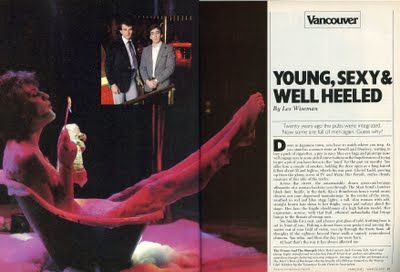 At the time writer Les Wiseman and were avid followers of the descendants of Salome and we came up with a ploy to convince Mac that it was worth a feature. We convinced him on the business side of exotic dancing. I think that in 1982 Mac had skillfully managed to keep his independence as an editor from the hands of our publisher Ronald Stern. It seemed like Mac could run articles about nonsense (such as the piece by Ben Metcalfe in this blog a few days past) or wild dogs in Iran and Stern would not protest about these stories not having the substance to attract advertisers to the magazine’s pages. In fact Mac came up with the idea for running two different covers that March. One was to feature the cat and the other a stripper. It would have been an experiment that would have preceded Chicago Magazine’s run a few years later featuring the city’s mayor smiling in one batch and serious in another. Stern quashed the plan and I never had to test the waters of demanding a double cover pay! The illustration to Laansoo’s piece is by our very own famous illustrator and animator Marv Newland. I suspect that he used a cheap copier type technology to come up with the concept. He did confirm with me (yesterday) that Laansoo did indeed provide him with the restaurant’s bill of sale as proof. In the illustration, the man on the left is Mati Laansoo. The man on the right (described as “my guide”) by Laansoo is Gary Marchant. Marchant wrote what is considered to be one of the best travel columns ever, anywhere, called Faraway Places for Vancouver Magazine. I remember with great fun the day that Marchant told me a story of traveling through some remote African country (it could have been Chad). He arrived at a small town exhausted and hungry. He inspected the large pot simmering over a fire at his little hotel. He spotted some bones in the stew. The cook gestured with his arms to represent a bird so Marchant assumed the stew was chicken or some similar fowl. He helped himself to a large portion. He was licking his chops when he spotted a little horrific skull staring at him. It was the little head of a bat. Perhaps my past, or at least my past as a magazine photographer was a rosier one. Perhaps the present with the universal and all-encompassing presence of the net has made those magazines of my era irrelevant. My friend Mark Budgen says I am sentimentalizing it. My friend John Lekich says that those magazines had heart and the present ones don’t. You who read this can be impartial judges. As for me I remember my grandmother’s words, “Nadie te quita lo bailado.” Nobody can take away from you the pleasures you had. And many pleasures I had reading the stories of Lansoo, Wiseman, Lekich, Marchant, Hunter (Bob), Metcalfe and many others who all wrote from the heart.
El Santo De La Trompeta
Thursday, March 04, 2010
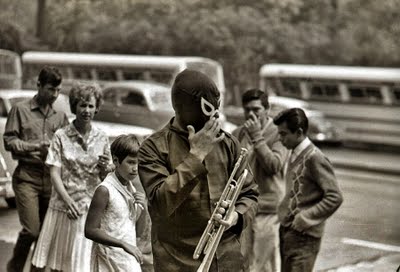
Throwing Dishes & Blueberry Cream Pies
Wednesday, March 03, 2010
I divide the people that populate our world in two. There are people who throw dishes in anger and those who don’t. I am from the first category.  On Sunday Rebecca stamped her feet and started yelling how she hated making pie crust. She showed it to me and told me, “It’s too hard. Something did not happen right.” And she promptly threw it into the kitchen trash can and stormed off. At age 12 we are all saying that Rebecca is at that point in her life where she is about to become a woman in body while the mind is not quite there yet. I am not all that sure of this. In 1957 I took this picture of my Revell replica plastic kit model S.S. Constitution (Old Ironsides) with an Agfa Silette. I placed my finished ship on a bed of cotton. The picture is not all that sharp. I have played around with Photoshop here to make it look like a fake late 19th century photo. My S.S. Constitution survived with many other models I built (cars, airplanes, ships and tanks) so that when I became a late teenager I gave them all away to my cousins, the Forments. There were several models that did not survive. One I remember well was H.M.S. Bounty. I was carefully applying the rigging (black thread) with tweezers when something just did not occur to my liking. I screamed. I got up. I threw the ship to the floor and then I jumped on it. My mother was all upset and almost in tears. I never quite outgrew these fits of destructive temper although I must confess here that when I am about to throw something I always weigh its value as opposed to its immediate need in my life. It might take a short second but I always think it first. I had been considered a gifted painter and drawer since I was 5 and by the time I was 10 I had been given many lessons. It was about then that I would become frustrated with an attempt to paint this or that that I would pick up my work in progress and tear it up as loudly as I could. At age 14 I suddenly and finally stopped painting. I received my last paliza (whipping) from my mother as punishment for my artistic block. My wife Rosemary, at first, like my mother did not know how to deal with my fits of temper. She would tell me to stop while screaming or crying. This always made it worse as I had an audience. In our early years of marriage most of the beautiful tea cups (some were Noritake or Wedgwood) went flying across the kitchen narrowly missing my distraught Rosemary. Here are two cups (the upper one is Wedgwood, and the lower Noritake) that survived my china onslaught. It took a while but Rosemary figured it out. She stopped being my audience and ignored my outbursts. These outbursts were almost always followed by intensely powerful migraines. My intelligent Rosemary gave me no comfort. It was sometime about 10 years ago when my weekly migraines suddenly ceased and I have not broken anything for years.  I observe in Rebecca something of myself. I am going to see if I can approach her with logic and explain how I was and how I regret the destruction of my H.M.S. Bounty. I have told her that anger and temper are never an excuse for rudeness. I think I will give her as a gift my two cups (I do have the saucers as Rosemary must have hidden them during one of my tantrums) and perhaps they will serve her as a guide to controlling her temper. Ever patient and low key Rosemary removed the pie crust from the trash can and rolled it out and lined a Pyrex pie plate. Rebecca was furious but she calmed down enough to say, “I will finish it.” This she did. She followed the recipe blindly and added the full count of sugar. The pie was too sweet. She was furious and refused to take a few slices home for her father. Just a few minutes before I started this I helped myself to the last slice of Rebecca’s blueberry cream pie. It may have been a tad sweet but thank God for women like my Rosemary.
Noble-Winged Seraphs Envied
Tuesday, March 02, 2010
Lolita, light of my life, fire of my loins. My sin, my soul. Lo-lee-ta: the tip of the tongue taking a trip of three steps down the palate to tap, at three on the teeth. Lo. Lee. Ta.
She was Lo, plain Lo, in the morning, standing four feet ten in one sock. She was Lola in slacks. She was Dolly at school. She was Dolores on the dotted line. But in my arms she was always Lolita.
Chapter 1, Lolita by Vladimir Nabokov

Some months back I took my two granddaughters to an Arts Club production of a musical called Nevermore: The Imaginary Life and Mysterious Death of Edgar Allan Poe. Even Lauren who is 8 managed to enjoy the musical play. She liked the costumes which resembled a modern Goth version of Alice in Wonderland. Rebecca had many questions on Edgar Allan Poe so I read The Telltale Heart to her after dinner. I did not do as a good a job as Iggy Pop and she found Poe a bit on the dull and repulsive side. She thought the Vincent Price version of The Fall of the House of Usher, renamed The House of Usher was cheesy. But at age 12 she knows more about Poe than the average 12-year-old and perhaps Poe might grow on her in the future.
My interest in Edgar Allan Poe began in 1957 when one of my English teacher Brothers of the Holy Cross at St Ed’s High School in Austin, Texas played a record in class. It was James Mason narrating Poe’s Annabel Lee. It was only a few weeks ago that I found the recording on one web page and as par for the course in this day and age of Google there is no information on date and record label. In fact my searches have taken me nowhere.
But I have a vivid memory of that recording but not vivid enough to remember that the recording had music in the background.
Thanks to James Mason I became a lifelong fan of all things Poe. I have read everything Poe wrote.
Of late I have read books in which Poe is a character such as in Matthew Pearl’s The Poe Shadow and Louis Bayard’s Pale Blue Eyes. The former is an extremely convoluted novel and the latter a bit more satisfying in which Poe, as a young cadet in West Point, assists a famous investigator after several brutal murders occur at the school.
I also liked Laura Lippman’s In A Strange City, 2001 (a novel in her series in which the main protagonist is a young female journalist-turned-investigator who lives in Baltimore, where Poe died and is buried). The novel centres around the well-known Baltimore ritual: Every year, on Edgar Allan Poe's birthday, a mysterious figure visits the writer's grave, leaving behind three roses and a bottle of cognac. When Tess gets wind of a plot to unmask the so-called Poe Toaster, she decides to stand guard. To her amazement, two visitors approach -- and one is shot and killed.
Some reader’s might know that for the first time ever the Poe Toaster did not show up this year on January 19.
I enjoyed a the 1951 film The Man With the Cloak (based on a short story, The Gentleman in Paris, by John Dickson Carr) with Joseph Cotten, Barbara Stanwyck, Leslie Caron and Louis Calhern. Cotton plays a failed poet called Dupin (!).At the end of the film, when Madeline (! The Fall of the House of Usher), played by Leslie Caron, goes looking for Dupin at a bar to thank him for a service rendered. Dupin's generous bartender Flaherty (Jim Backus) tells her he has gone, leaving only a seemingly worthless IOU for his sizable bar bill. On one side is a draft of a verse about a woman named Annabel Lee and the IOU's signature, which reveals Dupin's real name: Edgar Allan Poe.
While researching a bit of Poe to explain to Rebecca, I found out the hitherto (for me!) connection between Edgar Allan Poe and Vladimir Nabokov. It seems that the novel (published in Paris in 1955) was going to be originally called A Kingdom by the Sea. Humbert Humbert’s first love (unconsummated) is a young girl called Annabel Leigh.

This has led me to be currently reading The Annotated Lolita, Edited and with a preface by Alfred Appel, Jr. Two bookmarks are compulsory equipment here to keep track of all the footnotes, explanations, parody, coincidences (probably all intentional on the part of Nabokov) of this annotated version.
This Lolita came to me via former Vancouver Magazine associate editor (“Rock’roll died after the Beatles.”) and Nabokov scholar, Don Stanley. Three weeks ago the door bell rang at 8 in the evening. I opened the door to Don Stanley and wife. He said, “I have something for you,” and handed me the annotated version of Lolita.

One mystery remains for me. Since we know Nabokov published Lolita in 1955 (Olympia Press, Paris). When did James Mason record his reading of Poe’s Annabel Lee? Was the recording a possible reason Mason was chosen for the role of Humbert Humbert in Kubrick’s film Lolita in 1962? Or was it all Nabokovian coincidence?
The stand-in for Lolita here is Vancouver actress and mother of two, Corrie Clark. Clark recently conveyed to me the following:
These days I am working hard on screenwriting, among the days of motherhood. I am currently writing a screenplay about Emily Carr and again, ironically her
relationship as a 'surrogate mother' to a little girl who eventually lived with her for a few years when she was ...yes, 12.
Lady Fey by Ben Metcalfe
Monday, March 01, 2010
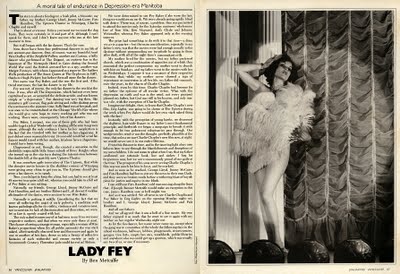 A moral tale of endurance in Depression-era Manitoba by Ben Metcalfe This story is about a fan dancer, a bush pilot, a Mountie, my father, my brother, George Lloyd, Jimmy McGuire, Fats Hamilton, the Uptown Theatre in Winnipeg, Charlie Chaplin and myself. That is about everyone. Unless you want me to count the dog team. They were certainly in it and part of it, although I can’t speak for them, and I don’t know anyone who can at this late moment in time. But it all began with the fan dancer. That’s for sure. Now, there have been four professional dancers in my life of any account qua dancer. One, of course was my beautiful Aunt Vera Dudley of the Ziegfield Follies; another was Carioca, a belly dancer who performed a the Dugout, an esoteric bar in the basement of the Metropole Hotel in Cairo during the Second World War until the British arrested her as a spy; another was Margot Fonteyn, with whom I appeared as a super in The Sadlers Wells production of The Snow Queen at the Orpheum in 1957, thanks to Hugh Pickett; but before them all came the fan dancer. Her name was Fey Baker, and she was the first, and if the trend continues, the last fan dancer in my life. Fey was not, of course, the only fan dancer in the world at the time. It was, after all, The Depression, which had not even been capitalized as yet, or accorded the definite article, and was known simply as “a depression.” Fan dancing was a very big then, like miniature golf courses, flag pole sitting and roller skating across the continent in the summer time. Sally Rand was at her peak, and very soon to be immortalized at the Chicago World’s Fair where she would give new hope to every working girl who was not working. There were, consequently, lots of fan dancers.  Fey Baker, I suspect, was one of those girls who had been unable to get a job at Woolworth’s or dealing off the arm in a greasy spoon, although the only evidence I have for her neophytism is the fact that she traveled with her mother as her chaperone. It just did not seem reasonable to my 13-year-old mind that a real fan dancer would travel with her mother, let alone have a chaperone. I could have been wrong. Chaperoned or not, though, she created a sensation in the clerkishly respectable little inner suburb of River Heights when she turned up as the star turn during the intermission between the double bill at the garishly new Uptown Theater. It was somehow aptly innovative of The Uptown, that while the cheaper movie houses in the shabbier corners of Winnipeg were giving away china to get you in. The Uptown should give you a fan dancer, so to speak. 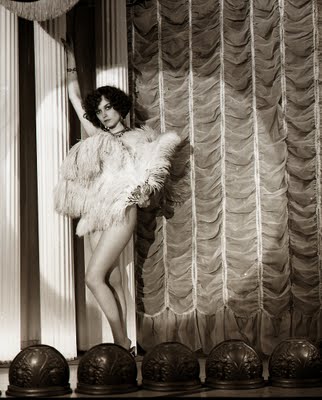 True, you did get to keep the china, but you had to see at least 48 movies to acquire a full set, whereas you could take in a full set of Fey Baker at one sitting. Naturally, my friends, George Lloyd, Jimmy McGuire and Fats Hamilton, and my brother Robert and I, all devout if sudden aficionados of the dance, were anxious to see Miss Baker. Naturally is putting it mildly. Considering that we were all suffering the angst of early puberty, a condition well known pathologically for its virility, virulence and voraciousness, not to mention its lack of discrimination and discretion, we were, let us face it, openly crazed with lust. The only naked woman any of us had seen in our lives were our respective mothers, and that when we were only three at most. The chance of seeing a strange woman, especially a woman of Miss Baker’s proportions when (by all public accounts) she was stark naked, albeit tactically obscures here and there now and again by one or another of her fans, drove us into a frenzy of collective fantasies of such recherché and rococo variety as only a Seventeenth Century Florentine jade could invent ad libitum. We were determined to see Fey Baker if she were the last thing we would see on earth. We were already going rapidly blind with desire. There was, of course, a problem. One was permitted to attend the movies only for the Saturday matinee’s wholesome fare of Tom Mix, Ken Maynard, Andy Clyde and Johnny Weismuller, whereas Fey Baker appeared only in the evening séances. The price had something to do with it in that time - a dime vis-a-vis a quarter – but the main consideration, especially in my father’s view, was that the movies were bad enough morally in the daytime without compounding our turpitude by going to them after dark, with all the night-time’s concomitant evils. My mother lived for the movies, but my father preferred church, which was a combination of opposites out of which they concocted the perfect compromise: my mother went to church with him on Sundays, and my father went to the movies with her on Wednesdays. I suppose it was a measure of their respective devotion that, while my mother never showed a sign of repentance or conversion in all her life, my father did succumb, over the years to the charms of Charlie Chaplin. 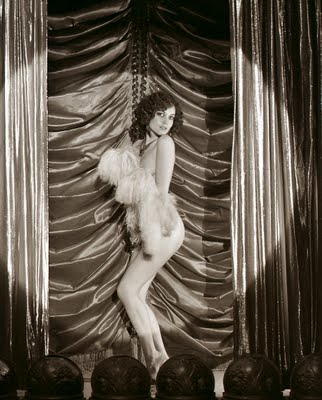 Indeed, even by this time, Charlie Chaplin had become for my father the epitome of all secular virtue. What with the depression on earth and war in the wind, not every prospect pleased my father, but God was still in his heaven, and only man was vile, with the exception of Charlie Chaplin. Imagine our delight, then, to learn that Charlie Chaplin’s new film, City Lights, was going to be shown at The Uptown during the week when Fey Baker would do her own stark naked thing with the fans! Instantly, with the perception of young hawks, we discerned the slightest, hair-wide fissure in my father’s most fundamental principle, and forthwith we began a campaign to breach it wide enough to let two pubescent voluptuaries pass through. Our wedge into his resolve was the thought, perfectly plausible at the time, that unless we saw Charlie Chaplin’s new film now, at night, we would never see it in our entire lifetime. From this distance in time, and in the taunting light of my own failures later to see through the blandishments and deceptions of my own children, I do not mean to gloat when I say that my father swallowed our rationale hook, line and sinker. I beg his forgiveness now, but we were uncommonly proud of our guile at the time. The prospect of his sons never seeing Charlie Chaplin’s film was too much for him to bear, and he cracked. And as soon as he cracked, George Lloyd, Jimmy McGuire and Fats Hamilton had but to convey the news to their own Dads, and they were as broken reeds before a withering blast of boyish pleas for justice and equity in our block. I can still hear Fats Hamilton’s old man musing along the lines that, if Joseph Bennet Betcalfe would make an exception in this case, James Hamilton sure as hell might, too. And so it was settled. We all went to see Charlie Chaplin and Fey Baker in City Lights on the opening Monday night: my brother and I, George Lloyd, Jimmy McGuire and Fats Hamilton. And all our fathers. And we all agreed it was a hell of a fine movie. My own father enjoyed it so much that he went to see it again with my mother on her regular Wednesday night out. As for the fan dancer, her name never came up, except when the gang was in a committee of the whole the following days in the school washroom, hallways, lobbies, playgrounds, street corners, garages, tree forts, empty box cars, woodsheds, public libraries and anywhere else we could get up a quorum, which was usually any two of us, or one if necessary. From one meeting to the next, it was moved, seconded and carried that Miss Baker had revealed more and more and more of her most intimate body to our committee than she had shown advertently or inadvertently to anyone. Within a matter of days, in fact, it became clear to us all that she might as well have left her mother the chaperone at home, for all the good she did, and her fans to boot, for all they concealed of her flesh. Very soon, then, we realized that she had singled us out in the front row, where we had persuaded our fathers that we could see City Lights better, and had been making desperately lewd attempts to get us to go home with her after the show. If one of us forgot momentarily some particular suggestive gesture on her part, or some interesting detail of her body, like a hair or an unusual coloration of the flesh in some out-of-the-way crevice, another would remind him of it without the slightest disjunction of continuity either in theory or in practice.’ The Uptown held her over for two weeks, but although she left town, we held her over as long as we could in our committee meetings until something better turned up, which it did not. And then the big story broke… The first I knew of it was from my father mumbling, “Well what do you know about that? “ and shaking his head reflectively as he passed The Winnipeg Tribune to my mother over their after-supper cup of tea. “Hmmmmmppphhh,” said my mother, after reading the headline and passing the paper back to my father. My mother never read more than the headlines, and then only at my father’s suggestion. Usually, he would read the entire edition, from the front page disasters to the back page horoscopes, then fold it up and put it down with the comment that there was nothing in the paper again. My mother knew that he was keeping an eye out for the Four Horsemen of the Apocalypse and would let her know in plenty of time it they should turn up at Portage & main. Meanwhile, she relaxed, or worried about whether Clark Gable was suited to Carol Lombard. This unusually sanguine attitude of my father to a piece of news did, however, arouse my own curiosity, and I turned my attention from my homework to the front page where the main headline screamed out in black letters the size of boxcars: FAN DANCER & BUSH PILOT DOWN IN NORTHERN BLIZZARD Yes, it was none other than our own Fey Baker, who had gone north from her Winnipeg engagements to entertain the miners in the then-new frontier mining town of Flin Flon. On the flight back, the plane had disappeared, and was long overdue. Now, whereas the Fey Baker fantasy had been held over, as I say, by our committee as long as it was feasible, it had been receding and becoming vaguely blurred and generalized quite naturally before the onslaught of the Stanley Cup play-offs and the careers of the brothers Conacher, etcetera. The news of Miss Baker’s plight jolted us back to fantasy. Without much delay, our committee met the next day in every possible nook and cranny of school and neighborhood to review this revitalizing turn of events, to concoct and embellish new scenarios and to take turns to play the role of bush pilot, whose luck we could not entirely believe. The fact that the fan dancer and her escort were lost in a mean temperature of some fifty below zero did not chill our imagination. Indeed, our imagination was too preoccupied even to think if about providing Miss Baker with anything warmer than her fans. How she endured, I have no idea. A fan dancer lost in the wilderness with a bush pilot! How can you impossibly improve on a story like that? Well you cold send a Mountie out to look for them with a team of sleigh dogs, couldn’t you? You certainly could, and they certainly did, and the ensuing tension was even more exquisitely unbearable. Hitler was taking over Germany from Field Marshall Hindenburg. Mussolini was preparing to seize the entire Mediterranean Sea, Britain was going off the gold standard, Dillinger was shooting up the United States, Roosevelt was launching his New Deal, the Liberal Party of Canada had been given a well-earned rest from power by the conservative Janitorial Party, and Japan was moving into China. But not as far as our committee was concerned. For us there was only one current event: Topic A. Unaccustomed as we were to reading more than the funnies and the hockey scores, we were now unconscionably interested in the front pages of the daily press insofar as they informed us the progress of the search for the fan dancer and her bush pilot and, as was bound to happen, the Mountie, too. Because, soon, enough, all three were lost, and apart from everything else, this created complications in our committee. We did not quite know, in our mid-western simplicity, how you handle this kind of ménage à trois. If we had even heard of a ménage à trois. The best we could come up with was that the bush pilot and the Mountie would simply have to take turns being in love with the fan dancer, while the fan dancer would simply have to be in love with whomever stayed in the cabin (we eventually built them a cabin, but Miss Baker still naked) while the other one went out to hunt for food and chop firewood. There was a certain reluctance for a long time, too, for many of us to become the Mountie. Not that we had anything against Mounties at the time. It was just that we had all got so comfortable in the role of the bush pilot. 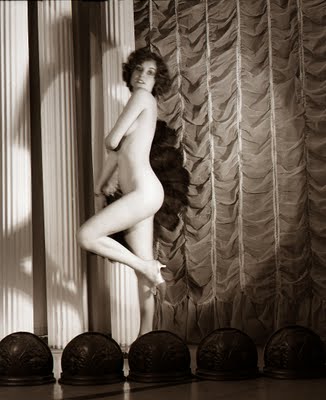 Meanwhile, the search went on. And, eventually, of course, the most publically exposed ménage à trois in Canadian history was found and brought back to civilization, where, as they returned, there was a great deal of public speculation as to whether Fey Baker would marry the bush pilot or the Mountie, It was written into the manners and the mores of that place and time that no girl, fan dancer or not, could spend so long in the bush with two men without marrying one of them very soon. My mother, who was a follower of such things as Rose Marie in real life, figured it would be the Mountie who got the girl. But my father pointed out that it would have to be the bush pilot, because the Mountie was under marrying age according to the prevailing stringencies of the Force. And there the matter ended as far as my parents were concerned As for our committee, we continued to raise the matter for speculation some time after it had dropped by society as a whole. We dallied, briefly, over the rumor that the sleigh dogs had suffered badly in the event, having been eaten by the Mountie the bush pilot and maybe even the fan dancer, too, just to keep up their strength in the rigors of the Manitoba winter. But this was never established incontrovertibly, though it has a plausible enough ring to it. Life eventually resumed its everyday course. George Lloyd became and anti-submarine bomber pilot in the RCAF, and survived to retire and play golf; Jimmy McGuire was shot down and killed over the North Sea as an air gunner with the RCAF; Fats Hamilton has been trying to console his parents for the loss of his brother Jim, with the Seaforth Highlanders; all our Dads are gone, of course. The Uptown Theater is now a bowling alley; and you know what happened to Charlie Chaplin, apropos which I must confess to the shades of those Dads that we did, in the event, get a number of other chances to see City Lights, although we had no way of predicting Television then. And, anyway, I have since figured that we are quits, seeing as how we helped them get to see the fan dancer, too. Maybe the bush pilot and the Mountie are still around and will come forward to sue me, and they are most welcome. There’s a couple of things I would like to ask them. As for the fan dancer, I never heard of her again, but I can say fondly and sincerely now, as Jimmy Durante might have said, “Good night, Miss Baker, wherever you are.” And with Browning, “How did we love you? Let me count the ways. “ First published in the January 1980 Vancouver Magazine Behind Lady Fey The photograph that appeared in the January 1980 issue of Vancouver Magazine which was used to illustrate one of my favourite pieces ever written by anybody (in this case by my friend, E. Bennet Metcalfe) has an interesting story on how it came about. In the late 70s and early 80s Vancouver Magazine was a Mecca for the best editorial illustrators of the city and the country. These were Marv Newland, Brent Boates, Ian McLeod, Ian Bateson, Barb Wood, Bernie Lyon and more that I cannot remember. In my presence (probably an editorial gaffe as I should not have been privy to the conversation) art director Rick Staehling proposed Metcalfe’s piece should be illustrated while the editor, Malcolm Parry argued for a photograph. Lucky for me Parry prevailed and I was assigned to shoot it. I chose a gay review club on West Pender Street called BJ’s because they had an old fashioned type stage and a spotlight. As my subject I chose my blood sucking friend Inga V who was an experienced dancer with and sans fans. Plus she had the added talent of being a makeup artist and stylist. I don't remember where we obtained the feathers. They probably had them in the costume department of BJ's. I have always been proud of my ability to shoot well-exposed and sharp photographs. For the first time (and last) I saw myself focusing and then unfocusing my lens a tad, to get and old-photograph blurred look. I helped this along by using a slow shutter which might have been 1/15 second or slower.
My Passion For Fashion
Sunday, February 28, 2010
This is a guest blog by my granddaughter Rebecca Stewart, 12.
I have always had a great passion for fashion. I find that fashion is like art, your clothes are the canvas, and the accessories are the paint which is the finishing touch for a great piece of art.

This first picture is one my favorite pictures because it reminds me of the picture of Gemma Ward in my Teen Vogue handbook that I keep in my brown pleather tote. The scarf I am wearing is a white printed scarf by Old Navy.

I would choose flats over tennis shoes any day because you feel pretty in them but there is no need to worry about foot problems, which stilettos will cause. I love the neutral metallic color of my Aldo statement flats.
One of my favorite things to do on a rainy afternoon is to bake. Though baking is entertaining, it can be messy as well, so my solution was to find a cute and useful apron, to protect my black clothes from flour dust.
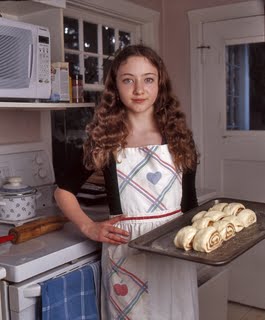
You wouldn’t believe that this blue satin-like dress is actually one of my grandmother's old night shifts she used to wear a long time ago. I just love the icy blue color.
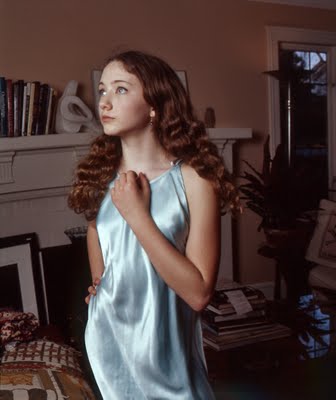
As you can tell I quite enjoy wearing scarves. This one I’m wearing is a floral printed scarf from Old Navy.

These days I have been wearing my turquoise Olympic sweater because the Vancouver Olympic Games are happening as I write. You might not see it but there is an inukshuk on the front of it.

I adore this painting (by Jim Cummins) of my mum, it looks like her. So I decided to wear this Twilight shirt because my mum is a real twi-hard.

This floral dress is one I got in Los Cabos Mexico. I felt it was appropriate to do my hair in a messy updo, to show the dresses halter straps. Behind me is a painting (Jim McKenzie) featuring my Aunt Ale and my mother on a ferry boat in Active Pass.
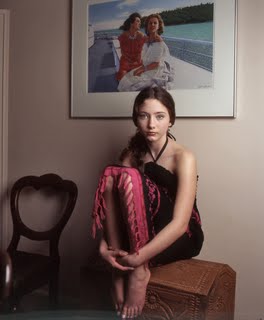
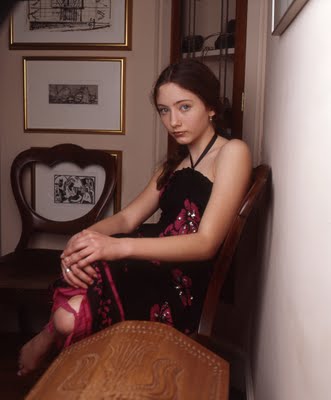
This shirt was given to me by friend Mina and I like the colors. That’s me in the background a long time ago.

This last photo is not that special but I still thought it would be nice to have it here because it includes my sister Lauren. I am playing the piano while wearing a very baggy button up shirt so I cinched it with a studded blue belt.
|
































